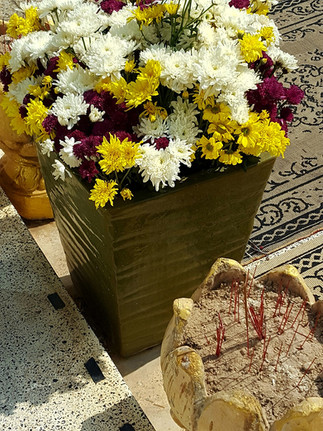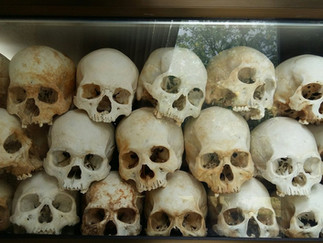The Killing Fields - Cambodia's Genocide
- Shannon
- May 21
- 4 min read
Located in the dusty outskirts of Phnom Penh lies Choeung Ek, the most infamous of Cambodia’s killing fields. Once a peaceful longan orchard, it now stands as a site of incomprehensible horror and grief. While over 300 killing fields have been identified throughout the country, Choeung Ek alone bore witness to the execution of more than 17000 men, women and children during the Khmer Rouge regime. The site contains 129 mass graves, only 86 of which have been exhumed. Skeletal remains, shards of clothing and teeth still surface after heavy rains, a grim reminder that the ground is far from silent. In 1988, a Buddhist stupa was constructed at the centre of the field, filled with more than 8000 skulls, many of them bearing signs of blunt force trauma. The eerie stillness of the site is shattered only by the ghostly whisper of wind through trees once used for slaughter.
The mastermind behind this genocide was Pol Pot, born Saloth Sar, who led the Khmer Rouge with an iron fist and a warped vision. His goal was to return Cambodia to a mythical, pre industrial utopia by eliminating all vestiges of modern society, capitalism and intellectualism. Upon taking control of Phnom Penh on April 17th 1975, Pol Pot’s forces emptied cities in a matter of days, forcing millions into labour camps under the pretense of national reconstruction. Those who resisted, or simply wore glasses, spoke a foreign language or held an education, were labeled enemies of the state. In his twisted ideology, even loyalty could be suspect. Spouses, siblings and children were often forced to denounce one another in a system where betrayal was survival and silence was a death sentence.
Conditions in the countryside were brutal and dehumanising. Entire families were separated and relocated to remote collective farms where starvation, disease and backbreaking labour claimed lives even before executions began. Medical care was virtually nonexistent, replaced by untrained “barefoot doctors.” Traditional culture, religion and even affection were outlawed. Weddings were arranged by the state and love was viewed as bourgeois sentiment. Torture centers like the infamous Tuol Sleng (S-21) prison processed victims before sending them to places like Choeung Ek. There, death was not a possibility but a certainty. Of the estimated 14000 people imprisoned at Tuol Sleng, only a handful survived.

Choeung Ek’s killing process was designed for efficiency and psychological domination. Trucks would arrive under the cover of darkness, packed with blindfolded victims. Loud propaganda music was blasted through speakers to muffle the screams of the dying. To conserve ammunition, soldiers executed prisoners with farming tools, bamboo sticks or sharpened sugar palm branches. Women were often raped before being killed. Children and infants were swung against the infamous “killing tree,” their tiny skulls crushed while their mothers were forced to watch. Mass graves were dug hastily, sometimes so shallow that bones protrude from the soil to this day. The cruelty was systematic, intentional and deeply personal.
Pol Pot's reign lasted until 1979, when the Vietnamese invaded Cambodia and toppled the Khmer Rouge regime. By then, an estimated 1.7 to 2.5 million Cambodians, nearly a quarter of the population, were dead. Pol Pot fled into the jungle, evading capture and living in relative obscurity until his death in 1998. He was never tried for his crimes. His leadership not only destroyed millions of lives but also decimated Cambodia's cultural and intellectual foundations, scars of which the nation still struggles to heal. The regime's legacy is one of silence, survivors rarely speak of what happened, trauma passed down quietly through generations.

Today, Choeung Ek stands as both a memorial and a warning. Each year on May 9th, Cambodians gather to remember the lives lost, placing offerings and lighting incense near the skull filled stupa. The site is not simply a tourist attraction but a place of mourning and education. It forces visitors to confront the darkest capabilities of mankind, the fragility of truth under tyranny and the price of blind ideology. Cambodia has made efforts to document and prosecute the horrors of the Khmer Rouge through the Extraordinary Chambers in the Courts of Cambodia but no measure of justice can restore the millions erased under Pol Pot’s vision. Choeung Ek remains, a graveyard not just of bodies but of history, dreams and humanity itself. Sadly, history is now repeating itself in Gaza.
Location : Choeung Ek Genocidal Center, Phnom Penh, Kingdom of Cambodia
How to get there : Choeung Ek is approximately 17 km’s south of Phnom Penh. For transportation, tuk-tuks are a popular and convenient option. A round trip journey from the city centre typically costs around $15 USD, with drivers waiting during your visit.
Attraction Info : The Killing Fields are open daily between 7:30am - 5:30pm. The entry fee is $6 USD per person, which includes a multilingual audio guide and headphones. This comprehensive audio guide provides detailed historical context and personal accounts. Visitors are urged to be respectful during their visit and remember where they are. Appropriate attire is expected and disrespectful selfies in front of skulls? Just don't. It’s important to be mentally prepared, as the exhibits and personal accounts are profoundly emotional and often disturbing. Smoking, drinking and eating are prohibited while touring the site.
Thanks for reading about The Killing Fields - Cambodia's Genocide. Check out more destinations here!



























